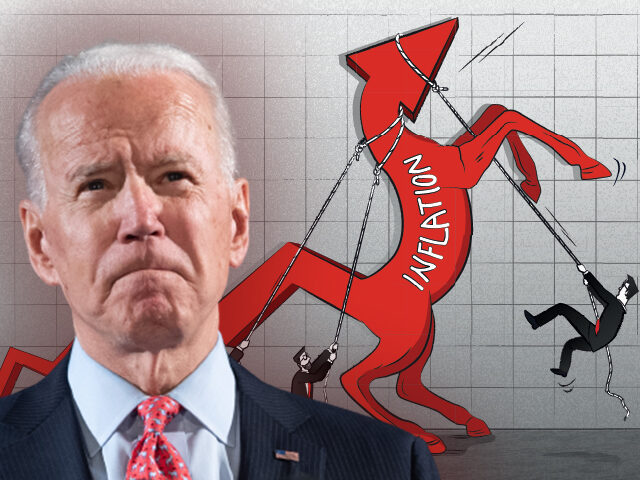Bidenflation Bites Harder
Inflation is increasingly a bummer for American households.
The share of U.S. adults telling pollsters at Gallup that they are experiencing financial hardship because of inflation climbed to 61 percent in the most recent survey, up from 56 percent in the August and November survey. The share saying they are experiencing severe hardship has held steady at around 15 percent; so, the increase comes from those saying they are experiencing moderate hardship.
It’s notable that the hardship of inflation has jumped even while inflation has retreated. The year-over-year increase in the consumer price index peaked at 9.1 percent way back in June, nearly 11 months ago. Yet the Gallup survey, which was conducted in mid-April, showed an increase in reported hardship. The simplest explanation for this is that it is not just the level of inflation that hurts but its duration.
A temporary bout of high inflation can be a one-time price adjustment. It can feel painful, but soon wages adjust to the higher regime. Ongoing inflation, however, often reduces real incomes. It also compounds as monthly price increases stack on top of the prior month’s increases. And, at this point, the annual increases are coming on top of last year’s increases.
There’s also likely a psychological tax to lengthy inflationary periods. People become exhausted with seeing the prices of household bills rise. The credibility of the Biden administration and the Federal Reserve has been eroded by numerous claims that inflation would be transitory, that it was rooted in temporary supply-chain hiccups, or that it had come to an end.
Inflation for the Long Run
Unfortunately, it’s very likely that we are facing a prolonged period in which inflation will run far above what the economy experienced prepandemic. The process of restoring manufacturing and decoupling from China will add to inflationary pressures. Increased risks of war and outright international conflict are inflationary. So is the trend away from growth policies and toward those fostering diversity, inclusion, and equity. The government-mandated transition toward supposedly cleaner energy will also push up prices.
This probably does not mean that we are in for nine percent inflation. But it does suggest that the underlying inflationary pressures are likely to push us toward three or four percent inflation. The Fed’s desire to bring us down to two percent inflation will mean that the policy rate will likely have to remain restrictive for longer, even through economic downturns. Easing to lift the economy will also lift inflation—so either we get higher inflation or higher interest rates for longer.
That’s not what financial markets anticipate. Bonds and stocks seem to be anticipating only a small hit to corporate profits that would not result in a wave of debt defaults or much lower corporate earnings. The bond and derivatives markets seem to be indicating the expectation that the Fed will cut rates even during a mild recession or that the Fed will conclude in just a few months that inflation is safely back on course to two percent. Given the trends supporting higher inflation, neither outcome seems likely.
U.S. households may have a better understanding of this than Wall Street. As we reported last week, consumer expectations for inflation over the long run are moving higher. In the May preliminary read from the University of Michigan survey of consumer sentiment, consumer expectations for inflation over the next five to 10 years moved to 3.2 percent, exceeding the 2.9 percent to 3.1 percent range it has been in for the past two years.
Biden Pushing the Fed in the Wrong Direction
Unfortunately, President Biden’s nominees to the Federal Reserve are not likely to be very helpful when it comes to inflation. They seem more interested in issues such as climate change and racial equity in the labor market than growth and price stability.
Allison Schrager, a columnist at Bloomberg Opinion, explains the trouble:
Monetary policy is at a critical point. The choices made by the Federal Open Market Committee in the next few years will determine if we get inflation under control, how fast our economy grows and what happens in financial markets. We need to be guided by the best economists and experts with deep knowledge of these issues, as well as of the trade-offs that balancing all these challenges pose. This should include at least one person in the group who possesses a deep understanding of the macro economy and how it interacts with financial markets.
But that’s not what we’re getting. President Joe Biden’s latest pick for the Fed’s Board of Governors, Adriana Kugler, is a great labor economist, but the board lacks anyone with financial macro expertise, and that’s what we need to get the economy through this difficult period…
Some might assume the choice of Kugler, a Latina, was because of diversity pressures. But there were other excellent economists from diverse backgrounds in the running who have the necessary expertise and could do the job better, as well as make a historic contribution. Janice Eberly or Ricardo Caballero would be a better choice.
Anyone paying attention should expect more inflation rather than less as the number of Biden appointments at the Fed rises.

COMMENTS
Please let us know if you're having issues with commenting.